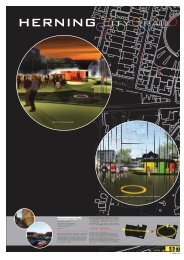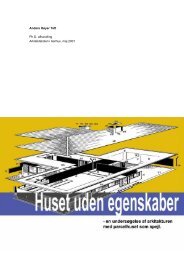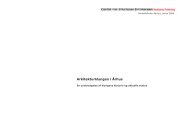art Anders Toft - Toft Arkitektur
art Anders Toft - Toft Arkitektur
art Anders Toft - Toft Arkitektur
You also want an ePaper? Increase the reach of your titles
YUMPU automatically turns print PDFs into web optimized ePapers that Google loves.
Latour has treated this phenomenon in his book We have<br />
Never Been Modern 24 from 1993. In this book he refers to the<br />
French philosopher Michel Serres concept Quasi-object. A<br />
Quasi-object is what is not fully an object and not fully a<br />
subject, but what lies between the two. What constitutes<br />
the two. Latour writes:<br />
The explanation we seek will indeed obtain Nature and Society,<br />
but only as a final outcome, not as a beginning. Nature<br />
does revolve, but not around the Subject/Society. It revolves<br />
around the collective that produces things and people. The<br />
Subject does revolve, but not around nature. It revolves around<br />
the collective out of which people and things are generated.<br />
At last the Middle Kingdom is represented. Nature and<br />
societies are its satellites. 25<br />
can act. Things and animals also act. Human society is stabilized<br />
and developed through an ongoing interaction between<br />
human and non-human actors 27 . The theory can be exemplified<br />
through the architectural practice: In order to reach a<br />
good, stabilized project an architect involves many sketches<br />
and models. He uses a computer, perhaps a drawing table,<br />
pens, rulers and so on. He uses books and photos for inspiration.<br />
The number of implicated actors could be expanded<br />
endlessly. This endless number of involved actors, both human<br />
and non-humans make up a large network, which is in<br />
fact Latours point. Any product is a stable state within a<br />
network of ongoing interaction.<br />
Latour in short wants to question the idea that we are in<br />
fact modern. He claims as I have just tried to show, that we<br />
have never been modern, and that philosophy based on this<br />
assumption is basically wrong.<br />
Modernity versus non-modernity<br />
If Latour is right it would be obvious to question the basic<br />
assumption of Kantian aesthetics and thereby also question<br />
the assumptions of Bourdieu based on Kantian aesthetics.<br />
On of the modern assumptions within Kantian aesthetics<br />
is that of disinterestedness. The subject has to be disinterested<br />
in what ever he or she wants to approach aesthetically.<br />
The disinterested approach will ensure a rational distance<br />
towards the object under aesthetic evaluation. This is<br />
necessary as the matter of aesthetic evaluation is a question<br />
of rational choice rather than a question of mere lust. The<br />
quest for beauty is a question of morality. A question of<br />
edification. Dag Østerberg writes:<br />
In opposition to Kant and also Bourdieu, Latour does not<br />
seek a philosophical offset in an insurmountable division<br />
between subject and object. And he definitely does not seek<br />
to patch up this division, which he claims has wrongly<br />
occupied western philosophy through out the last, at least,<br />
400 years 26 . Within the Latourian world there may be subject<br />
and object, but these are constantly ’infecting’ each other<br />
turning into quasiobjects and quasisubjects.<br />
In order to describe this world Latour uses the term<br />
ANT (Actor Network Theory). The main idea within this<br />
theory is that human subjects are not the only actors who<br />
The aesthetic approach is directed towards the beautiful or<br />
sublime about the objects, and both beauty and the sublime<br />
are pointing towards the kingdom of morality. Beauty is a<br />
’Symbol der Sitlichkeit’, while the sublime symbolizes the<br />
law of the moral and the respect, with which it inspires us. 28<br />
The aesthetic approach in this way helps man beyond pure<br />
lust towards a meaningful path of duty. Putting it a little<br />
different this means that man as a natural being, an animal,<br />
always will be inclined to arrange his life as an animal, following<br />
his basic instincts. But when nature is approached,<br />
not by instincts but aesthetically, Man will find moral<br />
edification within the beauty of nature. The experience of<br />
beauty in nature helps Man come to terms with the fact<br />
6 Nordisk <strong>Arkitektur</strong>forskning 2004: 2







